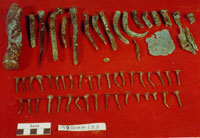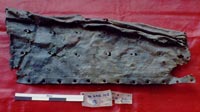 |
|
Maritime
Lanka |
14 Dec 2001
|
|||
| Last modified: 14 Dec 2001 |
 'Site
G' is the site of a wooden wreck on the eastern side of the bay of Galle, characterised
by a mound of ballast stones and a few scattered artefacts.
'Site
G' is the site of a wooden wreck on the eastern side of the bay of Galle, characterised
by a mound of ballast stones and a few scattered artefacts.
Based on archival information, a new hypothesis was developed in 1997 identifying Site G as the VOC ship Geinwens, wrecked in 1775. The clues pointing in this direction were:
Apart from these ‘physical’ clues, there were more general indications that Site G could be the remains of the Geinwens. Although the report on the wrecking of the Geinwens was not very clear about the spot in which the ship was sunk, it does say that the wrecked hull could be used in times of distress. This could mean that the ship was scuttled in a strategic place where ships could make an emergency stop before running aground or wrecking on the rocks. Site G, just before the cliffs, could be a logical place.
 However
there is also a very strong indication against this hypothesis. During the 1992
and 1993 survey and excavation, remains of substantial copper alloy sheathing
were found. Although Dutch shipbuilders used copper sheathing on parts of the
hull (the stem and the stern) from the early 17th century onwards, it was only
at the end of the 18th century that they started experimenting with copper sheathing
for all of the hull which was underwater. By the 1780’s the Dutch admiralty
started to sheathe whole ships with copper. They adopted the French way of copper
sheathing, so a link with the name Nante on one of the found sheets is
possible, and this need not conclusively prove French origin - although a pair
of calipers labelled Limoges also points in that direction. Recently
it has been suggested that the VOC had already started sheathing their Asia-bound
ships in the 1740’s.
However
there is also a very strong indication against this hypothesis. During the 1992
and 1993 survey and excavation, remains of substantial copper alloy sheathing
were found. Although Dutch shipbuilders used copper sheathing on parts of the
hull (the stem and the stern) from the early 17th century onwards, it was only
at the end of the 18th century that they started experimenting with copper sheathing
for all of the hull which was underwater. By the 1780’s the Dutch admiralty
started to sheathe whole ships with copper. They adopted the French way of copper
sheathing, so a link with the name Nante on one of the found sheets is
possible, and this need not conclusively prove French origin - although a pair
of calipers labelled Limoges also points in that direction. Recently
it has been suggested that the VOC had already started sheathing their Asia-bound
ships in the 1740’s.
There are no positive indications that Site G is indeed the Geinwens. The original suspicion that the site is French has been strengthened by the geologist's report that the ballast rocks are certainly not Sri Lankan, nor Dutch, and could be French. From the archives we know that the Geinwens loaded additional ballast of local rock. In order to find the Geinwens, further archival research should be done to identify other places in the bay that are appropriate for sinking a ship as a harbour facility.
| Maritime Lanka homepage | Galle index | Stone anchors |